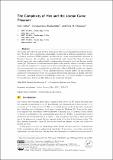The Complexity of Hex and the Jordan Curve Theorem
Author(s)
Adler, Aviv; Daskalakis, Konstantinos; Demaine, Erik D
DownloadThe complexity of hex.pdf (1.154Mb)
PUBLISHER_CC
Publisher with Creative Commons License
Creative Commons Attribution
Terms of use
Metadata
Show full item recordAbstract
The Jordan curve theorem and Brouwer's fixed-point theorem are fundamental problems in topology. We study their computational relationship, showing that a stylized computational version of Jordan’s theorem is PPAD-complete, and therefore in a sense computationally equivalent to Brouwer’s theorem. As a corollary, our computational result implies that these two theorems directly imply each other mathematically, complementing Maehara's proof that Brouwer implies Jordan [Maehara, 1984]. We then turn to the combinatorial game of Hex which is related to Jordan's theorem, and where the existence of a winner can be used to show Brouwer's theorem [Gale,1979]. We establish that determining who won an (implicitly encoded) play of Hex is PSPACE-complete by adapting a reduction (due to Goldberg [Goldberg,2015]) from Quantified Boolean Formula (QBF). As this problem is analogous to evaluating the output of a canonical path-following algorithm for finding a Brouwer fixed point - and which is known to be PSPACE-complete [Goldberg/Papadimitriou/Savani, 2013] - we thereby establish a connection between Brouwer, Jordan and Hex higher in the complexity hierarchy.
Date issued
2016-07Department
Massachusetts Institute of Technology. Computer Science and Artificial Intelligence Laboratory; Massachusetts Institute of Technology. Department of Electrical Engineering and Computer ScienceJournal
43rd International Colloquium on Automata, Languages, and Programming (ICALP 2016)
Publisher
Schloss Dagstuhl, Leibniz-Zentrum für Informatik GmbH
Citation
Adler, Aviv, Constantinos Daskalakis, and Erik Demaine. "The Complexity of Hex and the Jordan Curve Theorem" In 43rd International Colloquium on Automata, Languages, and Programming: ICALP 2016, Rome, Italy, July 12-15, 2016. Article no. 24; pp. 24:1-24:14.
Version: Final published version
Other identifiers
Track A: Algorithms, Complexity and Games
Article no.24
ISBN
978-3-95977-013-2
ISSN
1868-8969